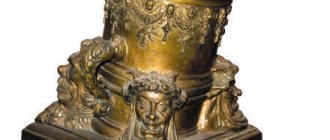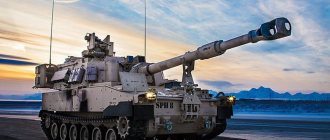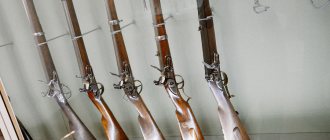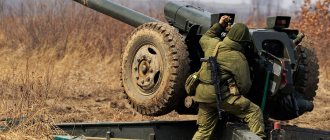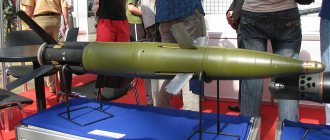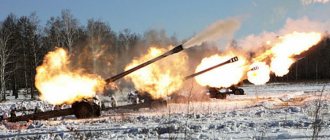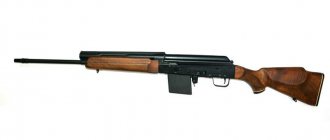History of development
The German Schwartz is considered to be the “father” of guns, but many historians agree that his merits in this matter are rather doubtful.
Thus, the first mention of the use of cannon artillery on the battlefield dates back to 1354, but there are many papers in the archives that mention the year 1324. There is no reason to believe that some artillery weapon had not been used before. By the way, most references to such weapons can be found in ancient English manuscripts, and not at all in German primary sources. So, especially noteworthy in this regard is the fairly famous treatise “On the Duties of Kings,” which was written in honor of Edward III.
The author was the king's teacher, and the book itself was written in 1326 (the time of Edward's assassination). There are no detailed explanations of the engravings in the text, and therefore one has to rely only on the subtext. So, one of the illustrations shows, without a doubt, a real cannon, reminiscent of a large vase. It is shown how a large arrow, shrouded in clouds of smoke, flies out of the neck of this “jug”, and at a distance stands a knight who has just ignited gunpowder with a hot rod.
First appearance
As for China, where gunpowder was most likely invented (and medieval alchemists discovered it no less than three times), there is every reason to assume that the first artillery pieces could have been tested even before the beginning of our era. Simply put, artillery, like all firearms, is probably much older than is commonly believed.
In the era of Charles the Bold, these weapons were already used en masse during the siege of fortresses, the walls of which by that time were no longer such an effective means of defense for the besieged.
Chronic stagnation
So why didn’t the ancient peoples conquer the whole world with the help of the “god of war”? It's simple - guns from the early 14th century. and 18th century differ little from each other. They were clumsy, overly heavy, and provided very poor accuracy. It was not for nothing that the first guns were used to destroy walls (it’s difficult to miss!), as well as to fire at large concentrations of the enemy. In an era when enemy armies marched at each other in colorful columns, this also did not require the high accuracy of cannons.
Let’s not forget about the disgusting quality of gunpowder, as well as its unpredictable properties: during the war with Sweden, Russian gunners sometimes had to triple the weight rate so that the cannonballs would cause at least some damage to enemy fortresses. Of course, this fact had a frankly bad effect on the reliability of the guns. There were many cases when nothing was left of an artillery crew as a result of a cannon explosion.
Other reasons
Finally, metallurgy. As with steam locomotives, only the invention of rolling mills and deep research in metallurgy provided the necessary knowledge to produce truly reliable barrels. The creation of artillery shells for a long time provided the troops with “monarchical” privileges on the battlefield.
Don’t forget about the calibers of artillery guns: in those years they were calculated both based on the diameter of the cannonballs used and taking into account the parameters of the barrel. Incredible confusion reigned, and therefore the armies simply could not adopt something truly unified. All this greatly hampered the development of the industry.
Schneider howitzer model 1916 (520 mm)
0
×
The 520 mm Obusier Mle 1916 rail-mounted mobile artillery system (better known as the "Schneider howitzer") was developed and built in France at the height of the First World War. Projectiles weighing about one and a half tons were supposed to be sent at a distance of up to 15 km. Despite the fact that two copies of the gun were built, they almost never took part in combat operations. The barrel of the first gun exploded during testing, and in 1941, during an attempt to shell Leningrad by Nazi troops, the second gun also collapsed.
Main types of ancient artillery systems
Now let's look at the main types of artillery pieces, which in many cases actually helped change history, refracting the course of the war in favor of one state. As of 1620, it was customary to distinguish between the following types of tools:
- Guns ranging in caliber from 7 to 12 inches.
- Feathers.
- Falconets and minions (“falcons”).
- Portable guns with breech loading.
- Robinets.
- Mortars and bombards.
This list reflects only “true” guns in a more or less modern sense.
But at that time the army had relatively many ancient cast-iron guns. Their most typical representatives include culverins and semi-culverins. By that time, it had already become completely clear that the giant cannons, which were to a large extent widespread in earlier periods, were no good: their accuracy was disgusting, the risk of the barrel exploding was extremely high, and it took a lot of time to reload. If we turn again to the times of Peter, historians of those years note that for each battery of “unicorns” (a type of culverin) hundreds of liters of vinegar were required. It was used diluted with water to cool barrels that were overheated from shots.
It was rare to find an antique artillery piece with a caliber greater than 12 inches.
The most commonly used were culverins, the core of which weighed approximately 16 pounds (about 7.3 kg). In the field, falconets were very common, the core of which weighed only 2.5 pounds (about a kilogram). Now let's look at the types of artillery pieces that were common in the past. Comparative characteristics of some ancient tools
| Gun name | Barrel length (in calibers) | Projectile weight, kilogram | Approximate effective firing range (in meters) |
| Musket | No specific standard | 0,45 | 50-75 |
| Falconet | 30 | 1,36 | 70-100 |
| Sacra | 28 | 4-5,4 | About 400 |
| "Aspid" | 20-25 | 4-5,4 | 1000-1067 |
| Standard gun | 17-21 | 9-45,4 | Up to 1300 |
| Half cannon | No specific standard | 13,6 | Up to 200 |
| Kulevrina (ancient artillery gun with a long barrel) | 33 | 9-22,7 | 230-250 |
| "Half" culverin | 32 | 5,4-13,6 | 150-170 |
| Serpentine | No data | 24 | About 300 |
| Bastard | No data | 18,6 | 400-700 |
| Stone thrower | 9-45,4 | 900-1000 |
If you looked carefully at this table and saw a musket there, do not be surprised. this was the name not only for those clumsy and heavy guns that we remember from films about musketeers, but also for a full-fledged artillery piece with a long barrel of small caliber. After all, imagining a “bullet” weighing 400 grams is very problematic!
In addition, do not be surprised by the presence of a stone thrower on the list. The fact is that, for example, the Turks, even in the time of Peter, made full use of barrel artillery, firing cannonballs carved from stone. They were much less likely to penetrate enemy ships, but more often they caused serious damage to the latter from the very first salvo.
Finally, all the data given in our table is approximate. Many types of artillery guns will remain forever forgotten, and ancient historians often did not have much understanding of the characteristics and names of those guns that were massively used during the siege of cities and fortresses.
Lazy Metta (735 mm)
0
At the beginning of the 15th century, the German master Henning Bussenschutte designed a bombard weighing about 9 tons. The gun, nicknamed the “Lazy Mette” (Faule Mette), with a caliber of about 750 mm, during tests sent a three-hundred-kilogram stone projectile to a distance of 2.5 km. The result is quite worthy for those times! The cannon fired, according to historical sources, more than 10 times at different times and its mere appearance inspired sacred awe in its opponents. Alas, at the end of the 17th century, the historical relic was melted down. History demanded guns - albeit with a smaller caliber, but with a larger number.
Innovators-inventors
As we have already said, barrel artillery for many centuries was a weapon that seemed to be forever frozen in its development. However, everything quickly changed. As with many innovations in military affairs, the idea belonged to naval officers.
The main problem with cannon artillery on ships was the serious limitation of space and the difficulty of performing any maneuvers. Seeing all this, Mr. Melville and Mr. Gascoigne, who was in charge of the production he owned, managed to create an amazing cannon, which today historians know as the “caronade.” There were no trunnions (mounts for the carriage) on its barrel at all. But it had a small eyelet into which a steel rod could be easily and quickly inserted. He clung firmly to the compact artillery piece.
The gun turned out to be light and short, easy to handle. The approximate effective firing range from it was about 50 meters. In addition, due to some of its design features, it became possible to fire incendiary shells. “Caronade” became so popular that Gascoigne soon moved to Russia, where talented craftsmen of foreign origin were always welcome, and received the rank of general and the position of one of Catherine’s advisers. It was in those years that Russian artillery guns began to be developed and produced on a previously unseen scale.
Barrel and rocket artillery: who is better?
Unlike traditional barrel systems, multiple rocket launchers provide virtually no noticeable recoil.
This is what distinguishes them from any self-propelled or towed gun, which, in the process of being brought into combat position, must be secured as firmly as possible and dug into the ground, since otherwise it may even overturn. Of course, there is no question of any quick change of position here in principle, even if a self-propelled artillery gun is used. Reactive systems are fast and mobile and can change their combat position in a few minutes. In principle, such vehicles can fire even while moving, but this has a bad effect on the accuracy of the shot. The disadvantage of such installations is their low accuracy. The same “Hurricane” can literally plow up several square kilometers, destroying almost all living things, but this will require a whole battery of installations with rather expensive shells. These artillery pieces, photos of which you will find in the article, are especially loved by domestic developers (“Katyusha”).
A salvo of one howitzer with a “smart” projectile can destroy any modern tank in one attempt, while a battery of rocket launchers may require more than one salvo. In addition, “Smerch”, “Hurricane”, “Grad” or “Tornado” at the moment of launch will not be able to be detected except by a blind soldier, since a significant cloud of smoke will form in that place. But such installations can contain up to several hundred kilograms of explosive in one projectile.
Barrel artillery, due to its accuracy, can be used to fire at the enemy when he is close to his own positions. In addition, the barreled self-propelled artillery gun is capable of conducting counter-battery fire, doing this for many hours. Multiple launch rocket systems wear out their barrels quite quickly, which is not conducive to their long-term use.
By the way, in the first Chechen campaign, “Grads” were used, which managed to fight in Afghanistan. Their barrels were so worn out that the shells sometimes scattered in unpredictable directions. This often led to the “covering up” of their own soldiers.
Dora (800 mm)
0
Preparations for World War II gave German gunsmiths the task of not only destroying megalithic fortified areas (which the Karl mortar did). It was necessary to shoot very far and quite accurately. This is how a giant named “Dora” with a caliber of 800 mm was created. The gun on a non-dismountable carriage had a total mass of 1,350 tons and could send seven-ton shells almost 40 km. Such a colossus needed more than just a railroad to move around—double-track sections with 4 rails precisely laid on reinforced ballast were specially prepared for it. The two guns were not only built, but even had time to fight. However, the advent of missiles with a much greater firing range and mobility of combat crews sent the “artillery dinosaurs” to the museum of historical curiosities.
The best multiple launch rocket systems
Russian artillery pieces "Tornado" inevitably take the lead. They fire 122 mm caliber shells at a distance of up to 100 kilometers. In one salvo, up to 40 charges can be fired, covering an area of up to 84 thousand square meters. The power reserve is no less than 650 kilometers. Coupled with the high reliability of the chassis and speed of up to 60 km/h, this allows you to transfer the Tornado battery to the right place and with minimal time.
The second most effective is the domestic 9K51 Grad MLRS, notorious after the events in the South-East of Ukraine. Caliber – 122 mm, 40 barrels. It shoots at a distance of up to 21 kilometers, and can “process” an area of up to 40 square kilometers in one pass. The power reserve at a maximum speed of 85 km/h is as much as 1.5 thousand kilometers!
The third place is occupied by the HIMARS artillery gun from an American manufacturer. The ammunition has an impressive 227mm caliber, but only six rails detract from the installation somewhat. The shot range is up to 85 kilometers, covering an area of 67 square kilometers at a time. Travel speed is up to 85 km/h, power reserve is 600 kilometers. It performed well in the ground campaign in Afghanistan.
In fourth position is the Chinese installation WS-1B. The Chinese did not waste time on trifles: the caliber of this terrifying weapon is 320 mm. In appearance, this MLRS resembles the Russian-made S-300 air defense system and has only four barrels. The range is about 100 kilometers, the affected area is up to 45 square kilometers. At maximum speed, these modern artillery pieces have a range of approximately 600 kilometers.
In last place is the Indian Pinaka MLRS. The design includes 12 guides for 122 mm caliber shells. Firing range – up to 40 km. At a maximum speed of 80 km/h, the car can travel up to 850 kilometers. The affected area is as much as 130 square kilometers. The system was developed with the direct participation of Russian specialists and has proven itself excellently during numerous Indian-Pakistani conflicts.
Karl (600 mm)
0
At the end of the 30s of the 20th century, Germany was actively preparing for a new war. Potential opponents, seeing full well where things were headed, became concerned with building titanic earthen and concrete fortifications along their borders. To break into fortified areas, German engineering talent created self-propelled artillery mounts with medieval shell parameters quite consistent with the nature of the fortifications. In particular, self-propelled mortars "Karl" with calibers of 540 mm and 600 mm fired at a distance of about 4 km with shells weighing 2 tons. A total of seven units were built on a tracked chassis. All of them received their own names - the names of the ancient Norman deities.
Guns
These weapons are far removed from their long-standing predecessors, who ruled the fields of the Middle Ages. The caliber of guns used in modern conditions ranges from 100 (Rapier anti-tank artillery gun) to 155 mm (TR, NATO).
The range of projectiles they use is also unusually wide: from standard high-explosive fragmentation rounds to programmable projectiles that can hit a target at a distance of up to 45 kilometers with an accuracy of tens of centimeters.
True, the cost of one such shot can be up to 55 thousand US dollars! In this regard, Soviet artillery pieces are much cheaper. Comparative characteristics of the most common guns produced in the USSR/RF and Western models
| Name | Manufacturer country | Caliber, mm | Weight of gun, kg | Maximum firing range (depending on the type of projectile), km |
| GHN-45 | Belgium | 155 | 8900 | 30-39 |
| GC 45 | Belgium | 155 | 8222 | 30-39 |
| BL 5.5 inch (out of service almost everywhere) | England | 140 | 5851 | 16,5 |
| "Zoltam" M-68/M-71 | Israel | 155 | 9500 | 21 |
| WA 021 (actual clone of the Belgian GC 45) | China | 155 | 9500 | 30-39 |
| M-46 | USSR | 130 | 8450 | 27 |
| 2A36 "Gyacinth-B" | USSR | 152 | 9800 | 27 |
| "Rapier" | USSR | 100 | 2800 | 3 |
| Soviet artillery guns S-23 | USSR | 180 | 21450 | 30,5 |
| D-20 | USSR | 152 | 5700 | 17-24 |
| "Sprut-B" | Russia | 125 | 6575 | 12,2 |
| G5 | South Africa | 155 | 13500 | 30 |
Mad Greta (660 mm)
0
Already during the decline of the Roman Empire, either at the end of the 14th or in the middle of the 15th century, one of the remarkable cannons was built in Belgium. “Dulle Griet” with a caliber of 660 mm has a mass of 16 tons and a quite decent cannon barrel with a length of about 5 m. Yes, it “has” - the cannon has fought quite a lot, but despite all the quirks of fate, it has survived to this day. Today it is the largest forged muzzle-loading gun preserved in museums.
Mortars
Modern mortar systems trace their origins to ancient bombards and mortars, which could fire a bomb (up to hundreds of kilograms in weight) over a distance of 200-300 meters. Today, both their design and maximum range of use have changed significantly.
In most armed forces of the world, the combat doctrine for mortars considers them as an artillery weapon for mounted fire at a distance of about a kilometer. The effectiveness of the use of these weapons in urban environments and in suppressing scattered, mobile enemy groups is noted. In the Russian army, mortars are standard weapons; they are used in every more or less serious combat operation.
And during the Ukrainian events, both sides of the conflict demonstrated that even outdated 88 mm mortars are an excellent tool both for guerrilla warfare and for countering it.
Modern mortars, like other cannon artillery, are now developing in the direction of increasing the accuracy of each shot. Thus, last summer, the well-known arms corporation BAE Systems for the first time demonstrated to the world community high-precision 81 mm mortar rounds, which were tested at one of the English test sites. It is reported that such ammunition can be used with all possible efficiency in the temperature range from -46 to +71 ° C. In addition, there is information about the planned production of a wide range of such projectiles.
The military pins particular hopes on the development of high-precision 120 mm mines with increased power. New models developed for the American army (XM395, for example), with a firing range of up to 6.1 km, have a deviation of no more than 10 meters. It is reported that such shots were used by the crews of Stryker armored vehicles in Iraq and Afghanistan, where the new ammunition showed its best performance.
But the most promising today are the developments of guided projectiles with active homing. Thus, domestic artillery guns “Nona” can use the “Kitolov-2” projectile, with which you can hit almost any modern tank at a distance of up to nine kilometers. Considering the low cost of the weapon itself, such developments are expected to be of interest to military personnel around the world.
Thus, the artillery gun is still a formidable argument on the battlefield. New models are constantly being developed, and more and more promising projectiles are being produced for existing barrel systems.

